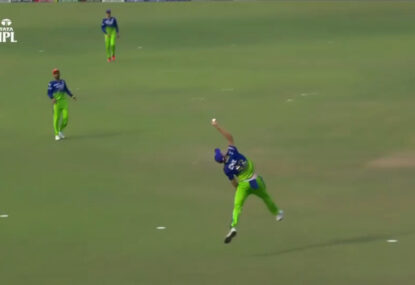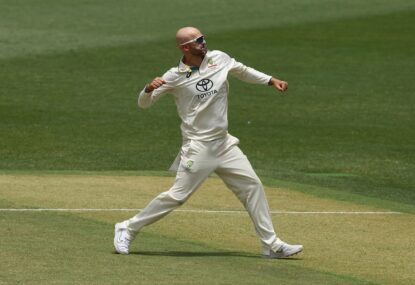The Ashes are over, bar a ‘dead rubber’ for the third time in two years. For the second time in those three, England have swamped Australia in the UK. This time around, the gulf has been wider and the difference between playing at home and playing away exposed to the point where it cannot be ignored.
That makes it easy. Fix a few issues, and all will be good next time. Except this has been a long time building.
Few Test series are won by the away team these days. England winning in India, and Australia in South Africa were rare feats. However, few, if any, Test nations have such a yawning chasm between home and home-like conditions, and those elsewhere. India at their peak were probably similar.
It is natural in sport, and it seems especially in cricket, that selectors get blamed. This time around, however, apart from taking Shane Watson on tour, they got very little definitively wrong. There were some other debatable choices, but few actually wrong. This series saw Australia’s best available XI, or very close to it, humiliated at Edgbaston and Trent Bridge.
The seed of this failure goes further back than who was picked for this squad.
Breaking the Shield season in half for the Big Bash League is a concern. However, for commercial reasons it will not be moving. That Test players hardly ever play a Shield match, or club cricket, is a bigger concern. The next group of players never get exposed to elite of the nation. There isn’t the learning from a Test player being in the rooms, or the chance to come up against that quality. The gap between the Shield and Test level is arguably greater than it has ever been.
The nature of the pitches on which the Shield is generally played is also an issue. The main venues in Australia have largely become homogenised batting tracks. When a few pitches were created with some grass on them the groundsmen were widely criticised and Cricket Australia issued a directive to not do that again.
Partly as a result of this, Australian batsmen play fast, true tracks as well as anyone in the world. As soon as the ball moves, however, wickets go.
Pitches need some life. There is little that can be done about swing, atmospheric conditions see to that. Some grass and seam can be retained. Maybe later in the season a few dry dustbowls. It is important not to go too far though, otherwise bowlers will be in the same situation batsmen are in now and unable to work through unhelpful conditions.
The addition of a point for a draw may help, over time. Until last summer there was very little incentive to try and draw a game from a position where the team was definitively behind. Batsmen now may need to learn to grind and graft under pressure, and bowlers can no longer rely on cheap wickets when batsmen hit out trying for an impossible run chase.
The structure of the Sheffield Shield, however, is as much symptom as it is cause.
With the retirements of Michael Clarke and Chris Rogers, and the probable axing of Adam Voges, Australia is likely to enter its first ever period where its Test batsmen may not have been taught a forward defensive shot first and learned other shots from that.
This is not a swipe at T20, the issue goes back further than that. While T20 does teach bad habits, it is an easy scapegoat, and if things were rectified at a younger age those habits could be applied to T20 only with little harm.
Almost since the introduction of Kanga Cricket, the focus has been on mass participation. This is a good thing for the game, it means that suburban and country clubs are more likely to find people willing to play the game they played as a child. Modified rules at junior levels, such as mandatory retirements at a certain score, mean that Johnny Nohope (which should have been my nickname in my ‘playing’ days of low-grade bush league) get a chance to bat and to bowl. They will be the ones to fill out an eleven, and attend matches as an adult. Or to rant pointlessly into the ether on places such as The Roar.
The problems come with encouraging hitting at a young age. There is no incentive for batsmen to learn correct techniques and no need for the talented to find a way to graft an innings in tough periods.
Retain the junior ranks as they are, mass participation is to be encouraged. However, there need to be changes to encourage players to learn the correct techniques. Coaches, and parents are often focussed on winning. That is fine, players must learn the value of the team. The issues comes with the fact that wining at that level means hitting to a mandatory retirement as quickly as possible. As a result, coaches have no reason to teach defence, straight bat, footwork, etc., as their most talented player is capable of flaying the opposition all over the park anyway.
Of course, many coaches are parents with little experience of coaching; doing a very good, unrewarded job on little knowledge but a lot of effort. That has always been the case, and those lucky enough to have a genuine coach at a young age will always have an advantage.
It should not be the job of the national coach, or a state coach, or even a state youth squad coach to teach the basics. They must be learned early, or else when the pressure is on and a player falls back on their instinct, that instinct will be all wrong.
Futures league, under 17 and under 19 tours, Sheffield Shield, Centres of Excellence, should be fine tuning and stepping up a level to apply what was learned much younger. That is not the case, and has not been for some time.
As captain, Ricky Ponting, went public with the lack of technique he saw from players entering the Test squad. And the problems go back further than that.
With such issues in junior ranks, it might be 20 years after applying a solution (if the solution is a good one) before bearing any fruit, just as the seeds of 60 (and 47 in South Africa, and 98 in Melbourne) were sown as early as the 1980s.
But will CA look at the whole game? After all, home matches are on free-to-air TV. Australia still wins those, so the bulk of exposure is to a winning team and the occasional debacle is quickly forgotten. The dedicated fan will watch on Fox regardless of how the side is travelling. So why would CA change anything?
More likely, on the England’s fastest and closest to Australian-like deck, The Oval, Australia will be competitive (maybe even win) and CA will talk about that match as a platform.
Then 60 will be forgotten as Australia trounce the West Indies at home. Once again, marketing will win over cricket. And things will be fine.
Until the next tour to the UK, or to India, or away to Pakistan wherever that may be held.




































































































